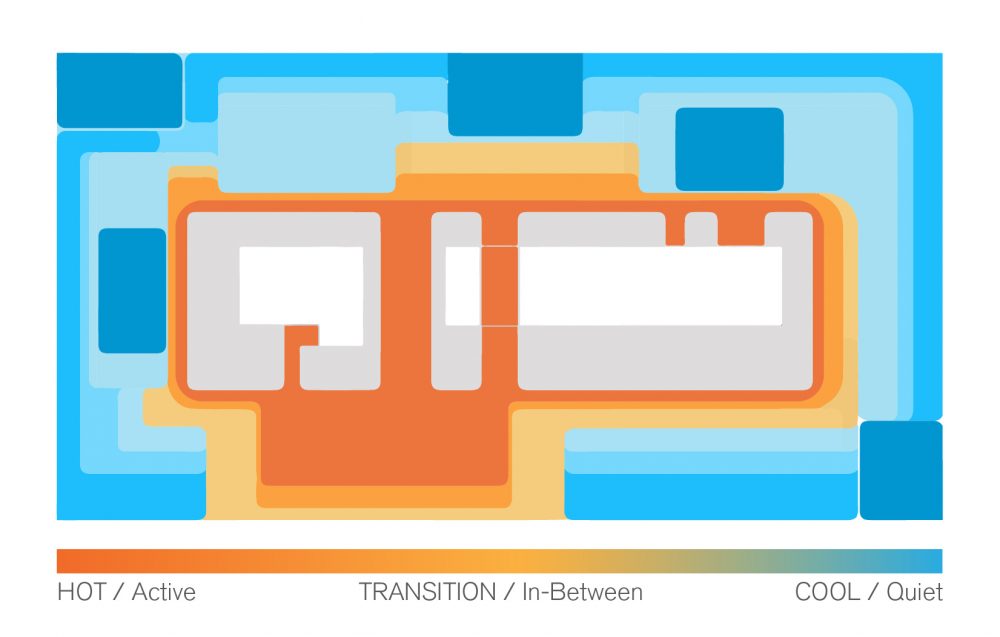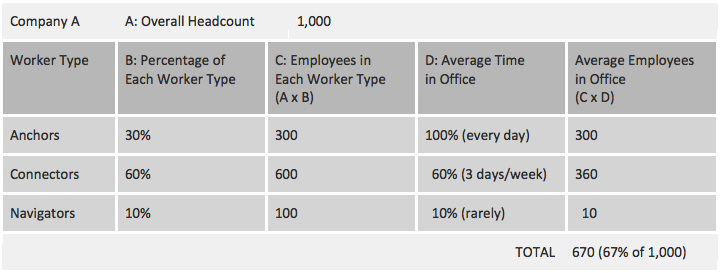Clive Wilkinson Architects introduces the New Workplace Kit of Parts featuring 12 reimagined spaces to support and enhance new ways of working in the post-COVID-19 workplace.

After a year of uncertainty in the pandemic, two things are clear – the office will live on, and we will not be returning to the way things were. The COVID-19 remote working experiment has put into focus what can – and can’t – be done without a physical workplace. The powerful social and collaborative benefits the workplace offers have also made themselves painfully clear as many of us have been forced to get by without them. Now that the vaccinated population is growing, organizations are faced with navigating the new landscape of work. This is where the challenging questions begin: Why will people come to the office? How will the office perform? Who will come to the office and how often? How does the office need to change based on all this?
A wide spectrum of work models has emerged ranging from ‘work anywhere’ to ‘100 percent in-office’. These extremes may be too radical for many organizations with ‘work anywhere’ employees feeling disconnected and ‘100 percent in-office’ employees feeling a lack of trust. The hybrid model arises as a reasonable middle ground, and there’s a growing body of research to support it. This model offers flexibility for employees to work part-time remote and part-time in-office. Studies show that 55 percent of employees would prefer to be remote at least three days a week once pandemic concerns fade.1 But this popular hybrid work model comes with its own challenges and demands a highly tailored approach for each organization.
In reflecting upon this paradigm shift, our team has thoughtfully considered where work has been and where it is going. This is an opportunity to transform and redefine the workplace – what parts we have outgrown and should be discarded and what new opportunities we can embrace. Our team has created the New Workplace Kit of Parts – 12 reimagined spaces to support and enhance new ways of working in the post-COVID-19 workplace.
After months of isolation and cultural disconnect, our Kit of Parts strives to prioritize collaboration, serendipitous encounters and connection to community and culture. These are not new concepts, but the pandemic has accelerated these ideas and acts as a catalyst for change.
A workplace must first and foremost support the unique business needs of the organization. The Kit of Parts has been developed as a framework to flex to business needs, office size, budget and locale. These spaces are not focused on short-term, pre-vaccine solutions – they instead aim to highlight how the human experience of work will change in the long-term post-COVID-19. They form a starting point to build upon. A complete workplace will have a variety of additional meeting rooms, support spaces, and specialty spaces unique to each organization.
Why will people come to the office?
Over the past year of remote work, we’ve had to make do without the physical workplace. And while there are certainly tasks that can be done from home effectively, what will drive people back to the workplace when it’s safe? This answer is unique for each organization, but the leading research and our clients point to three key drivers: Collaboration, Serendipitous Encounters and Connection to Community and Culture.
The first driver, Collaboration, is an obvious one. That’s not to say that all virtual collaboration is challenging, however certain types such as group brainstorming and ideating are difficult to do remotely. Whether it be sketching, pinning up, or strategic business planning – the virtual tools still cannot replace in-person interactions.
The second driver, Serendipitous Encounters, are nonexistent in the work from home world. Occurrences like running into a colleague while grabbing coffee or quickly exchanging ideas while walking to a meeting simply cannot happen while working remotely. Cross-functional knowledge sharing is sorely lacking without communal spaces designed to facilitate it. According to research by Cushman & Wakefield, over a third of employees engaged in remote work during the pandemic do not feel like they are learning. Specifically, formal process learning is continuing but informal learning and mentoring are challenged.2
The last driver to the office is Connection to Community and Culture. Over our 30 years of designing workplaces, we’ve found that this is what distinguishes incredible organizations. Workers want to be connected to their colleagues, company mission and purpose. These are leading reasons for increased productivity, innovation and commitment. According to research, half of employees struggled to connect with their company’s culture during the COVID-19-induced remote work experiment.2 Community doesn’t only contribute to workers wellbeing but also leads to better business outcomes. A successful workplace design will enhance a company’s unique community and culture to massively inspire and engage their workforce.
Like what you’re reading? This is the first of four parts in a series – follow us all month long for more!

How will the office perform?
The energy of the workplace should be designed with intention and purpose. We often call this the acoustic landscape of the office as it maps the full spectrum of spaces from “hot” or active to “cool” or quiet. The “hot” zones support louder, more energetic activities, while the “cool” zones support more focused work. The New Workplace Kit of Parts covers the full energy spectrum with a variety of “hot” spaces, “cool” spaces, and “transition” spaces in between.
While we believe the new workplace will prioritize collaborative and community space, it must accommodate and promote all styles of work – collective and individual, active and quiet – to enhance employee performance and ultimately improve satisfaction and retention. This promises a more diverse, varied and indeed richer environment.
We envision the new workplace to have more diversity and choice in where employees can work than ever before, moving away from the one-size-fits-all office for good. One of the most common complaints about the open office is distraction. It’s no surprise this is a significant challenge when workers are expected to collaborate and concentrate in one homogenous space. The New Workplace Kit of Parts addresses this by providing distinct spaces for collaboration and concentration, and employees are empowered to choose where they want to work based on the task at hand. The idea is that employees will be more productive when they have the right spaces for the work they need to accomplish.

Who will come to the office and how often?
Long before the pandemic, we understood that the one-size-fits-all office was extremely flawed. This is because workers have a vast range of needs that can vary by location, department, role, seniority, and even personality. We often find that companies have three types of employees: Anchors, Connectors and Navigators.3
‘Anchors’: The Resident Office Workers
Anchors spend much of their time in-office. They are very autonomous and rarely leave their personal work settings or immediate surroundings. Anchors may be fixed to a certain location and may require access to in-office resources like paper files.
‘Connectors’: The Hybrid Workers
Connectors have a hybrid work schedule, spending part of their time remote and part in-office. Many employees have proven they can be productive remotely, and we believe that the hybrid work model will become more commonplace than ever before. Connectors come into the office regularly for specific tasks that can’t be done (or can’t be done as well) remotely. They are mobile while in the office, moving around to different spaces based on the task at hand.
‘Navigators’: The Remote Workers
Navigators are highly mobile, and their work can be done anywhere. Navigators rarely use the office, accessing it to exchange information and attend meetings. They come to the workplace as needed, which could be a few days per month for a strategic brainstorming session or an all-hands event. Since these worker types interact with the office in different ways, there are distinct combinations of the New Workplace Kit of Parts that support them best.
For example, an administrative team may have mostly in-office resident workers or Anchors so they will have more “cool” spaces to support their independent, individual work. On the other hand, a sales team may have more remote workers or Navigators so they will have more “hot” spaces to support collaboration and community-building when they come to the office.
Each organization will have its own unique mix of these worker types. By determining the approx. percentage of each type, organizations can better understand the overall space utilization of their workplace and ultimately how much space is needed in the future. In the example below, we’ve determined an overall space utilization of 67 percent. On any given day, about 670 employees out of 1,000 will be in the office.

Putting it all together
With so much uncertainty about the future of work, office design must be more adaptive to evolving organizations than ever before. The New Workplace Kit of Parts is developed as a framework to flex to unique business needs and constraints. The Kit of Parts can be implemented strategically, ranging from simple furniture updates to more involved architectural renovations. The new agile workplace must expand and contract intelligently to respond to whatever the future holds.
The COVID-19 pandemic has been the largest remote working experiment in history and presents a transformational opportunity to reimagine the new workplace. Employees have changed and are expecting their workplaces to change as well. Leadership is taking action – less than one in five executives say they want to return to the office as it was pre-pandemic.1
Research shows there’s a preference for hybrid working, but what does that look like? Stay tuned as this four-part series will take a deep dive into the New Workplace Kit of Parts and offer specific solutions to support the workforce post-pandemic. These 12 building blocks of the new workplace will be analyzed for their function, features and sensory experience to bring color to each.
___________________________________________________________________________
1 PwC (2021, Jan 12). US Remote Work Survey. https://www.pwc.com/us/remotework?WT.mc_id=CT10-PL102-DM2-TR1-LS3-ND30-PR4-CN_ViewpointHighlights-
2 Cushman & Wakefield. (2020). Purpose of Place: History and Future of the Office.
3 Greene, Catherine. (2011, Feb). Space for thought: Designing for knowledge workers. Royal College of Arts.


